
38 Leda is a large, dark main-belt asteroid that was discovered by French astronomer J. Chacornac on January 12, 1856, and named after Leda, the mother of Helen of Troy in Greek mythology. In the Tholen classification system, it is categorized as a carbonaceous C-type asteroid, while the Bus asteroid taxonomy system lists it as a Cgh asteroid. The spectra of the asteroid displays evidence of aqueous alteration.
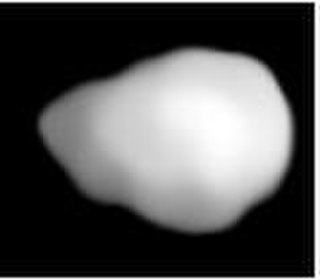
41 Daphne is a large asteroid from the asteroid belt. It is a dark-surfaced body 174 km in diameter is probably composed of primitive carbonaceous chondrites. The spectra of the asteroid displays evidence of aqueous alteration. It was discovered by H. Goldschmidt on May 22, 1856, and named after Daphne, the nymph in Greek mythology who was turned into a laurel tree. Incorrect orbital calculations initially resulted in 56 Melete being mistaken for a second sighting of Daphne. Daphne was not sighted again until August 31, 1862.

54 Alexandra is a carbonaceous asteroid from the intermediate asteroid belt, approximately 155 kilometers in diameter. It was discovered by German-French astronomer Hermann Goldschmidt on 10 September 1858, and named after the German explorer Alexander von Humboldt; it was the first asteroid to be named after a male.
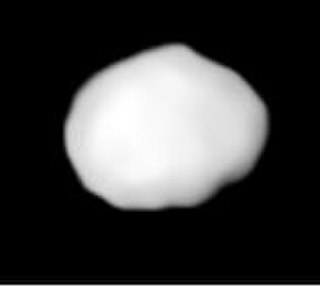
88 Thisbe is the 13th largest main-belt asteroid. It was discovered by C. H. F. Peters on 15 June 1866, and named after Thisbe, heroine of a Roman fable. This asteroid is orbiting the Sun at a distance of 2.768 AU with a period of 4.60 years and an orbital eccentricity (ovalness) of 0.165. The orbital plane is inclined at an angle of 5.219° to the ecliptic.

93 Minerva is a large trinary main-belt asteroid. It is a C-type asteroid, meaning that it has a dark surface and possibly a primitive carbonaceous composition. It was discovered by J. C. Watson on 24 August 1867, and named after Minerva, the Roman equivalent of Athena, goddess of wisdom. An occultation of a star by Minerva was observed in France, Spain and the United States on 22 November 1982. An occultation diameter of ~170 km was measured from the observations. Since then two more occultations have been observed, which give an estimated mean diameter of ~150 km.
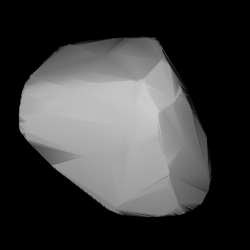
104 Klymene is a large, dark Themistian asteroid that was discovered by J. C. Watson on September 13, 1868, and named after one of the many Clymenes in Greek mythology. It is orbiting the Sun with a period of 5.60 years and an eccentricity of 0.16. The orbital plane is inclined by 2.8° to the plane of the ecliptic. It is classified as a C-type asteroid, indicating it probably has a carbonaceous composition. The spectra indicates the presence of aqueous-altered minerals on the surface based upon a sharp feature at a wavelength of 3 μm, and, as of 2015, is the only member of the Themis family found to show this absorption.

105 Artemis is a main-belt asteroid that was discovered by J. C. Watson on September 16, 1868, at Ann Arbor, Michigan. It was named after Artemis, the goddess of the hunt, Moon, and crossways in Greek Mythology.

109 Felicitas is a dark and fairly large main-belt asteroid. It was discovered by German-American astronomer C. H. F. Peters on October 9, 1869, and named after Felicitas, the Roman goddess of success. The only observed stellar occultation by Felicitas is one from Japan.

111 Ate is a main-belt asteroid discovered by the German-American astronomer C. H. F. Peters on August 14, 1870, and named after Ate, the goddess of mischief and destruction in Greek mythology. In the Tholen classification system, it is categorized as a carbonaceous C-type asteroid, while the Bus asteroid taxonomy system lists it as an Ch asteroid.

114 Kassandra is a large and dark main-belt asteroid. It belongs to the rare class T. It was discovered by C. H. F. Peters on July 23, 1871, and is named after Cassandra, the prophetess in the tales of the Trojan War.

137 Meliboea is a large, dark main-belt asteroid that was discovered by Austrian astronomer J. Palisa at the Austrian Naval Observatory on 21 April 1874, the second of his many asteroid discoveries. It was later named after Meliboea, the daughter of Oceanus and Tethys in Greek mythology. The largest body in the Meliboea family of asteroids that share similar orbital elements, only 791 Ani approaches its size. It is classified as a C-type asteroid and may be composed of carbonaceous materials. The spectra of the asteroid displays evidence of aqueous alteration.

144 Vibilia is a carbonaceous asteroid from the central region of the asteroid belt, approximately 140 kilometers in diameter. It was discovered on 3 June 1875, by German–American astronomer Christian Peters at Litchfield Observatory of the Hamilton College in Clinton, New York, United States. Peters named it after Vibilia, the Roman goddess of traveling, because he had recently returned from a journey across the world to observe the transit of Venus. Peters also discovered 145 Adeona on the same night. The official naming citation was published by Paul Herget in The Names of the Minor Planets in 1955.
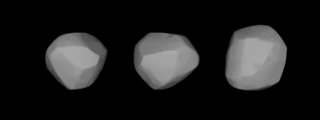
146 Lucina is a main-belt asteroid that was discovered by Alphonse Borrelly on June 8, 1875, and named after Lucina, the Roman goddess of childbirth. It is large, dark and has a carbonaceous composition. The spectra of the asteroid displays evidence of aqueous alteration.

194 Prokne is a main-belt asteroid that was discovered by German-American astronomer C. H. F. Peters on March 21, 1879, in Clinton, New York, and named after Procne, the sister of Philomela in Greek mythology. Stellar occultations by Prokne have been observed twice, in 1984 from Italy and again in 1999 from Iowa.
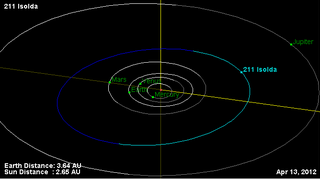
211 Isolda is a very large, dark main-belt asteroid. It is classified as a C-type asteroid and is probably composed of primitive carbonaceous material. The spectra of the asteroid displays evidence of aqueous alteration.

225 Henrietta is a very large outer main-belt asteroid. It was discovered by Austrian astronomer Johann Palisa on April 19, 1882, in Vienna and named after Henrietta, wife of astronomer Pierre J. C. Janssen. The asteroid is orbiting at a distance of 3.39 AU from the Sun with a period of 6.24 years and an eccentricity (ovalness) of 0.26. The orbital plane is inclined at an angle of 20.9° to the plane of the ecliptic. 225 Henrietta belongs to Cybele group of asteroids and is probably in a 4:7 orbital resonance with the planet Jupiter.

247 Eukrate is a rather large main-belt asteroid. It is dark and probably a primitive carbonaceous body. The asteroid was discovered by Robert Luther on March 14, 1885, in Düsseldorf. It was named after Eucrate, a Nereid in Greek mythology.

313 Chaldaea is a large Main belt asteroid. It is classified as a C-type asteroid and is probably composed of carbonaceous material. It was discovered by Johann Palisa on 30 August 1891 in Vienna. It was named in honor of the Chaldeans, considered the founders of astrology.
405 Thia is a very large main-belt asteroid. It is classified as a C-type asteroid and is probably composed of carbonaceous material. This object was discovered by Auguste Charlois on July 23, 1895, in Nice, and was named after Theia, a Titaness in Greek mythology.
488 Kreusa is a C-type asteroid orbiting the Sun in the asteroid belt, with the type indicating a surface with a low albedo and high carbonaceous content. The spectra of the asteroid displays evidence of aqueous alteration.



















